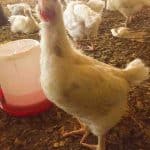By FarmersJoint in Livestock Farming 
Vaccines help to prevent or minimize the impact of viral diseases. They are important because viral diseases cannot be treated with drugs. They can only be prevented with vaccines. If a poultry farmer is not careful to follow certain rules, the vaccine he administer will fail to protect his birds from viral diseases. And when this happens, many farmers end up blaming the vaccine manufacturers.
Vaccines can be given to birds through drinking water, by injection, eye drop, spray etc. The most common route for broiler is via drinking water and wing web puncture (for fowlpox vaccine). For egg layers it is via drinking water, wing web puncture (for fowlpox vaccine) and injections. You can get sample vaccination/medication plans for layers and broiler below:
Vaccination/Medication Plan for Layers Vaccination/Medication Plan for Broilers
Below are rules that will help you prevent vaccine failure:
1. Vaccinate healthy birds
>>>>>> [Read more…] <<<<<<
By FarmersJoint in Livestock Farming 
Below is broiler medication and vaccination chart you can follow. Vaccinating your birds against viral diseases is very important because viral diseases are incurable. Vaccination will help to prevent or reduce the severity of viral diseases.
Medication on the other hand, is used to treat or prevent diseases caused by bacteria, fungi or protozoa. But if you follow good biosecurity measures, you can reduce the amount of medication you give.
Here goes the chart:
Day 1: Marek vaccine: This is usually given to the chicks at the hatchery.
On getting to your brooding pen, give them multivitamins and minerals in water. Provide broiler starter feed in enough feeder such that all of them can feed at the same time without struggle.
Day 2-4: Multivitamins and antibiotics. Recommended antibiotics include …..
Day 5: Gumboro vaccine via drinking water.
Day 7: Lasota for Newcastle disease
Day 10-12: Anti-coccidiosis drugs and
>>>>>> [Read more…] <<<<<<
By FarmersJoint in Poultry 
Litter beetles are those dark beetles you find in poultry houses, most especially in deep litter houses. They normally hide under everything – drinkers, feeders, stones, laying boxes that are on the floor, along the walls etc. In my early days of raising chickens, I totally ignore these beetles because I thought they were harmless. But are they harmless? They are VERY harmful!
Litter beetles
Litter beetles eat chicken feed, their larvae bore into insulations, woods etc, they climb into poultry feathers and bite them, sometimes killing weakened chickens and worst of all, they can carry a lot of poultry diseases!
The scientific name for these little destroyers is Alphitobius diaperinus. Locally, they can also be called darkling beetles, lesser mealworm, black beetles etc. They cause more problems in houses where the litter is allowed to build up without any effective control program in place.
>>>>>> [Read more…] <<<<<<
By FarmersJoint in PoultryWhen you get your day old chicks, it is important to do what is called “day old chick screening”. Day old chick screening has a lot of benefits that can save you from disaster. It helps you to know the right time to vaccinate your birds and tells you the right antibiotics to use.
Although there are established vaccination plans that will work for most people in an area, DOC screening is still important because Hatcheries can make mistakes. Some vaccination plans may tell you to vaccinate for Newcastle disease on day 7. But because of hatchery mistake, the chicks may actually need the vaccine on day 5 to prevent disaster. DOC screening will help you discover this.
Due to the cost of this screening (N7000 as of 2015), it may not be favorable to those who has less than 500 or 1000 chicks as the case may
>>>>>> [Read more…] <<<<<<
By FarmersJoint in PoultryJust like humans, birds require different types of feed at different stages of growth. Below are the types of feed given to broilers and layers.
Feed for Broilers
Broiler Starter: This is high in protein and energy and is given from day old until 4-6 weeks old.
Broiler Finisher: This has a lower protein and energy content than starter. It is given from about 4-6 weeks until target weight is attained.
Feed for Laying Birds
Starter: Layers can be given broiler starter in their chick stage. This is given for the first 8 weeks. They can also be given chick mash.
Grower Feed: Given from 8 to 20 weeks or when 5-10% of the birds start laying.
Layers Feed: It is introduced when 5-10% of the birds start laying and it is given until the birds are sold.
Feed for Cockerels
Broiler/Chick Starter: Given for the first 6 weeks.
Low
>>>>>> [Read more…] <<<<<<
By FarmersJoint in PoultryBroiler Production:
Broilers are meat birds that have been genetically conditioned to grow very fast. They attain market weight (over 2kg) in 6-10 weeks depending on management. They can get sick easily if you don’t manage them well. Broiler chicks goes for N200-N280/chick.
Space Requirement: Stock at 20-25 chicks/m2. 8 weeks old broilers requires 900cm2 or 0.09m2 per bird. See: House Size For Chicken for details.
Feed Requirement for broilers: A broiler requires about 8kg of feed within the first 8 weeks. It consumes about 2kg in the first 4 weeks and about 6kg from 5 to 8 weeks. They’re given starter feed for the first 4-5 weeks and broiler finisher feed until they attain the desired market weight (at 6-9 weeks of age depending on market demand). See broiler feed and body weight chart below.
Broiler feed and body weight chart
Keeping broilers beyond 9
>>>>>> [Read more…] <<<<<<
By FarmersJoint in PoultryChicks need warmth and to satisfy this they are raised in brooders. The chick stage is one of the most critical stages in the life of chickens. If there is loss of performance during the first week, it can hardly be compensated for later in life. Under good management, chicks can increase their body weight by fourfold or more in the first week. To achieve this in the first week, below are some management tips that will help.
#1. Avoid Caked or Wet Litter:
One of the most important functions of litter is to absorb moisture. Chicks retain only about 20% of the water that they consume and the remainder is excreted onto the floor. If litter becomes excessively wet, it will cake up. Caked or wet litter result in high ammonia production but when coupled with the high temperature required for brooding, much more ammonia will be produced.
>>>>>> [Read more…] <<<<<<
By FarmersJoint in PoultryDo you know that birds can waste a lot of feed? Your carelessness can also contribute to that. Below are some helpful tips that will help you avoid this costly wastage:
Debeaking: Debeaking or beak trimming has to do with cutting off the sharp points of the lower and upper beak. It helps to prevent cannibalism, feather pulling and feed wastage. Un-debeaked birds can waste 5 times the feed debeaked birds will waste.
Debeaking is a delicate operation that must be done by trained operators. Error can result in birds having difficulties with eating and drinking. This will eventually lead to unevenness in the flock (lack of uniformity).
Use the right feeder: In both round and straight feeders, feed wastage can be prevented by: Using feeders that have a lip (see Fig below) ensuring that the feeder is not more than 1/3-1/2 full Feeder depth should be at least
>>>>>> [Read more…] <<<<<<
By FarmersJoint in PoultryFig 1: Suspending the feeder so that the base is at the same level as the bird’s back will help reduce feed wastage & prevent dirt from entering the feed.
Laying birds need feed that are nutritionally balanced because of their high level of production. Imagine a laying hen laying 230-300 eggs per year. To maintain this high performance, they need well balanced feed. Let’s look at quality and quantity of feed.
Quality of Feed
For maximum/optimal productivity, your layers will need feed that are specially formulated to meet their nutritional requirement. The feed should be fresh and free from mould.
Throughout their life, your birds might need starter, grower, developer, pre-lay and layers feed. But the most common among these feeds are starter, grower and layers feeds. A change is made from one type of feed to the other only when the birds have attained a target
>>>>>> [Read more…] <<<<<<
By FarmersJoint in PoultryDebeaking (also called beak trimming) is the act of cutting the lower and upper points of the beaks. The trimmed upper beak is usually shorter than the lower beak. Debeaking birds will help prevent feed wastage, cannibalism, feather pecking, and egg eating. Mortalities due to cannibalism can reach up to 15% in un-debeaked laying hens that are housed in aviaries, straw yards and free range systems. However when they are kept in smaller groups in cages, cannibalism is reduced. Birds that are normally debeaked are laying hens, turkeys, quail and ducks. Broilers meant for meat are not debeaked because they reach slaughter weight before injurious pecking start. However broiler breeders are debeaked because they are kept for a long time.
Debeaking machine
Debeaking a bird
Types of Debeaking Methods
There are two debeaking methods, namely the hot and cold methods. With hot method, the beak is cut and
>>>>>> [Read more…] <<<<<<
|
Join the Forum Do you want to discover more great info like these?
Register for free and ask your question in our farming forum! Our knowledgeable members will have your questions answered.
FarmersJoint.com strives to maintain accurate and up-to-date information; however, mistakes do happen and we won't be held accountable for anything that result from the use of information provided in this site. If you would like to correct or update any of the information, please send us an e-mail. THANK YOU!
|


